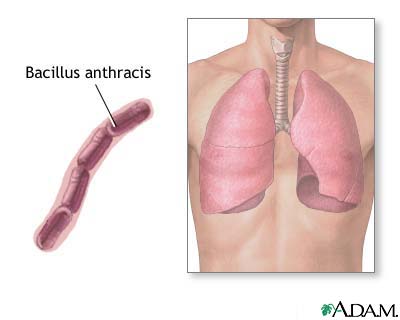In 2001, terrorists attacked. Their weapon of choice? Anthrax. Almost a decade later, the anthrax mail attack is still foremost in people’s minds when they think of bioterrorism. But what is anthrax, really?
Anthrax is a rod-shaped (bacillus) bacterium formally known as
Bacillus anthracis [See figure 1]. It is a part of the cellular organisms domain, specified into the bacteria kingdom, part of the fermicutes phylum, of the bacilli class, subdivided into the bacillales order, further specified into the bacillaceae family, then divided into the bacillus genus and finally identified in the bacillus cereus species.
Bacillus anthracis is endemic (native) to Asia, southern Europe, sub-Sahelian Africa and parts of Australia. It is found in soil, where its spores can last for generations. It mainly affects cattle, sheep, goats, camels, horses, and pigs in addition to the humans who care for them.
Anthrax is a lethal disease. Even though it doesn't cause your brain to explode, it's just as deadly. After being introduced into the body, the bacteria produces three compounds known as lethal factor, endema factor and protective antigen. Alone, lethal factor and edema factor are harmless, but with the addition of protective antigen they become deadly. Protective antigen binds to cell receptors, which then cut the protein in half. The halves bind separately to each of the factors, transforming them into lethal toxin and edema toxin. The two toxins each stop cell regulation via the signaling pathways, which results in cell death due to either necrosis (premature cell death) or apoptosis (cell suicide). Anthrax especially targets the immune system and blood vessel linings most likely because they require either downstream ERK activity or Mek1/2 pathway in order to reproduce. This mass cell death eventually results in either death by infection (the immune system's down) or death by lack of functioning (the cells are dead and therefore cannot perform any more).
Evidently, anthrax is nothing to be taken lightly. In 2001 this was shoved home as twenty-two people were infected. Although only five died, it was still a shell shock to the American society. Anthrax was the unanimous super-villain. Now, as people everywhere learn more about anthrax, they are able to fully appreciate the risks-whether they be large or small.

Figure 1 (Bacillus anthracis: MedlinePlus Medical Encyclopedia Image)Read MoreWikipedia's
article. Read this first, then the rest of the stuff...it'll make a LOT more sense, I promise
Click
here for the effects, in all their pseudo-gory detail, of lethal toxin and edema toxin.
More lethal toxin and edema toxin effects
here. It's a lot simpler and there's a link to the rest of the article for free!
Oh, wait. They're all like that.
And now, on to the
World Health Organization.
Here they are.
Last but not least, our lovely
Centers for Disease Control. They had to work hard after that mailing...and here's
the evidence.
Anyway, that was this week's episode of
How It Gets To You. Stay tuned throughout the year to (maybe) hear about more!
(Unless, of course, this is offensive. In that case I apologize and sincerely hope that you spell your criticizing comments right)
-[Asian X]



